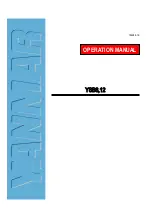
13.2
TORQUE PROGRAMMING
An external signal may be used to program torque. A voltage of 6 volts
will give that torque preset by the internal torque pot when using the 6 volt
board power supply. If a larger value of programming voltage is available,
it must be scaled down by a voltage divider network so that the maximum
voltage that appears at 1TB-8 (+) in respect 1TB-5 (common) is 6 volts. A
voltage variation of from zero to 6 volts between terminals 8 (+) and 5
(common) on 1TB will program a maximum torque capability of from
zero to that value preset by the internal torque control potentiometer.
Normally the internal torque potentiometer is set to limit current at 150%
of rated current when internal torque programming is used. When external
torque programming is used the “torque” potentiometer on the E1507 PC
board is in many cases readjusted so that with 6 volts present at 1TB-8 in
respect to common, the control will limit current to 100% of rated current.
(The “torque” potentiometer on the E1507 PC board has sufficient range
to limit current anywhere from approximately 75% to 150% of rated
motor current with 6 volts present at terminal 8 (+) in respect to common.
When the control is supplying 100% of rated motor current, there will be,
approximately, a 33mV voltage drop across the current shunt 1MSH.) In
order to accomplish external torque programming, the yellow jumper on
the E1507 PC board must be unsoldered from the “Int. Torq.” Position
terminal, then resoldered to the “Ext. Torq.” Position terminal. Refer to
Figure 6.3
14.
TACHOMETER FEEDBACK
The OC2 can easily be transferred to tachometer feedback by means of
changing the position of the FB select jumper on 2PL. With pins 1 and 2
jumpered together, the OC2 uses armature voltage feedback. With pins 2 and 3
jumpered together, the control uses tachometer voltage feedback. Initially, the
drive should be operated in the armature voltage feedback mode. A
measurement can be made to determine proper tachometer polarity and
approximate magnitude. The procedure to use is as follows:
a)
Refer to table IV for necessary board modification if any. The control
has been set up to handle the most commonly used base speed motor
and tachometer combinations. Table IV gives the base speed and
tachometer voltage ratings that will work with the board as designed.
For some combinations, a resistor must be clipped from the board. For
motor and tachometer combinations not covered in this manual,
consult the Polyspede factory.
19











































